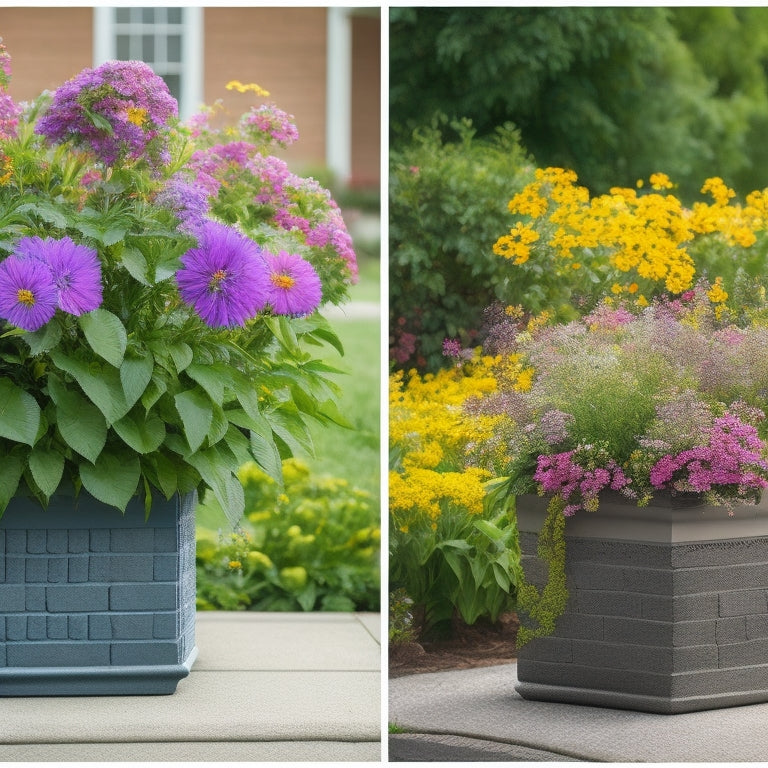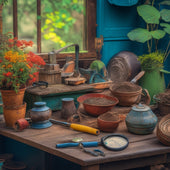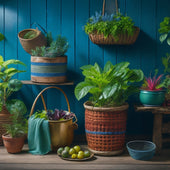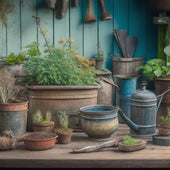
Transforming Cinder Blocks Into Stunning Planters Step-By-Step
Share
You're about to give cinder blocks a stunning makeover! First, gather essential materials like cinder blocks, sand, gravel, and mortar mix. Prepare the blocks by cleaning and inspecting them for damage, then apply a decorative coating like acrylic paint or epoxy to enhance their appearance. Next, add a layer of soil and drainage material, followed by your chosen plants, considering factors like sunlight and climate. Finally, seal your planter with a waterproofing agent to protect it from the elements. With these steps, you'll be well on your way to creating a breathtaking planter that showcases your personal style - and there's even more to discover.
Key Takeaways
• Clean and inspect cinder blocks for damage, then prepare them for use by removing dirt and debris with a wire brush.
• Add a layer of gravel or broken pottery to prevent waterlogged soil and ensure good drainage in your planter.
• Apply a decorative coating, such as acrylic paint or epoxy, to enhance the appearance of your cinder block planter and protect it from the elements.
• Plant a mix of textures, colors, and sizes, leaving enough space for growth and air circulation, and top with decorative mulch.
• Seal your planter with a waterproofing agent to protect it from moisture and temperature extremes, making it easier to clean and maintain.
Gathering Essential Materials
You'll need to gather several essential materials to create your cinder block planters, including cinder blocks, sand, gravel, mortar mix, water, a shovel, a trowel, and a level.
When selecting cinder blocks, consider the type that suits your project best. Solid cinder blocks provide more structural integrity, while hollow blocks offer better drainage solutions. You may also opt for decorative blocks with a smooth finish for a more polished look.
For drainage, you can add a layer of gravel or broken pottery at the bottom of the planter to prevent waterlogged soil. Additionally, make sure to have a sufficient amount of sand, as it will help with drainage and provide a stable base for your plants.
With these materials at hand, you'll be well-prepared to start building your cinder block planters. Remember to follow the manufacturer's instructions for the mortar mix and take necessary safety precautions when working with the materials.
Preparing Cinder Blocks
With your materials gathered, it's time to prepare your cinder blocks for assembly by cleaning them thoroughly with a wire brush to remove any dirt or debris. This step is essential to guarantee a strong bond between the blocks and any adhesives or coatings you'll apply later. You'll want to focus on the areas where the blocks will connect, as any dirt or grime can compromise the structural integrity of your planter.
Next, inspect your cinder blocks for any cracks or damage. If you're using old or reclaimed blocks, you may need to repair or replace them to ensure they can hold the weight of the soil and plants.
Consider the type of cinder block you're using, as some may have varying levels of porosity that can affect drainage. You may need to implement additional drainage solutions, such as drilling holes or adding a layer of gravel, to prevent waterlogged soil.
Adding Decorative Coatings
After preparing your cinder blocks, it's time to give them a decorative makeover by applying a coating that not only enhances their appearance but also provides additional protection against the elements. You can choose from a variety of decorative paints and textural finishes to achieve the look you want.
Here are some popular options to evaluate:
| Coating Type | Description | Benefits |
|---|---|---|
| Acrylic Paint | Water-based, vibrant colors | Easy to apply, durable, and UV-resistant |
| Epoxy Coating | Thick, glossy finish | Chemical-resistant, waterproof, and long-lasting |
| Concrete Stain | Transparent, earthy tones | Enhances natural texture, easy to apply, and low maintenance |
When applying your chosen coating, make sure to follow the manufacturer's instructions and take necessary safety precautions. You may need to prime your cinder blocks before applying the coating, depending on the type you choose. With a little patience and creativity, you can transform your plain cinder blocks into stunning planters that will elevate your outdoor space.
Planting and Arranging
Now that your cinder blocks are transformed into vibrant planters, it's time to add the pièce de résistance – the plants themselves – and arrange them in a way that showcases their beauty and complements your outdoor space.
When it comes to plant selection, consider the amount of sunlight your planters will receive, as well as the climate and soil type. Choose plants that thrive in similar conditions, and don't be afraid to mix and match different textures, colors, and sizes to create visual interest. Consider adding a statement piece, like a bold succulent or a showy flower, to draw the eye to the planter.
For arrangement tips, start by adding a layer of soil and a drainage material, like small rocks or pebbles, to the bottom of the planter.
Then, add your plants, leaving enough space for growth and air circulation. Don't overcrowd the planter, as this can lead to disease and pests.
Finally, add a decorative mulch or top dressing to complete the look and help retain moisture.
With a little creativity and planning, your cinder block planters will be the envy of the neighborhood!
Sealing and Protecting
To guarantee your cinder block planters remain vibrant and durable, seal them with a waterproofing agent to protect them from the elements and prevent damage from moisture and extreme temperatures. This important step guarantees your planters withstand the test of time and continue to thrive.
You can choose from various waterproofing techniques, such as applying a concrete sealer, silicone-based spray, or a waterproofing membrane. Make certain to follow the manufacturer's instructions for application and drying times.
Sealing your planters is essential for long-term maintenance. Water can seep into the cinder blocks, causing erosion and weakening the structure. By sealing your planters, you'll prevent water from penetrating the surface, reducing the risk of damage and extending their lifespan.
Additionally, waterproofing will make cleaning easier, as dirt and debris won't be able to penetrate the surface. Take the time to properly seal your cinder block planters, and you'll enjoy their beauty and functionality for years to come.
Final Touches and Display
With your cinder block planters fully sealed and protected, you can focus on adding the final decorative elements that bring your outdoor space to life. This is where your personal style and creativity shine through.
Start by selecting plants that complement each other regarding texture, size, and color. Consider bold, vibrant plants like succulents or flowering perennials to add visual interest. When choosing plants, think about the overall aesthetic you want to achieve – do you prefer a cohesive look or a playful mix-and-match approach?
Next, consider the color combinations that will tie your planters together. You can choose plants with similar hues or create a bold contrast with complementary colors.
Don't forget to add some decorative touches like small ornaments, pebbles, or moss to fill in any gaps and add texture.
Finally, arrange your planters in a way that creates a visually appealing display. You can group them together, create a pattern, or place them strategically around your outdoor space.
With these final touches, you'll be amazed at how your cinder block planters transform into stunning focal points that enhance your outdoor oasis.
Frequently Asked Questions
Can I Use Cinder Blocks With Cracks or Broken Edges for Planters?
You're wondering if you can use cinder blocks with cracks or broken edges for planters. The answer is yes, but you'll need to take some precautions.
First, assess the damage and decide if the block can still hold its shape. If it's salvageable, use repair techniques like epoxy or concrete patching to fix the cracks.
Then, follow planting tips like using a sturdy liner and adding drainage holes to guarantee your plants thrive.
With a little TLC, you can still create a beautiful planter from an imperfect block.
How Often Should I Water Plants in Cinder Block Planters?
You'll want to water your plants in cinder block planters when the top 1-2 inches of soil feel dry to the touch.
Since cinder blocks have low moisture retention, you'll need to water more frequently than with traditional planters.
Check the soil daily, and water every 2-3 days in hot weather or every 4-5 days in cooler temperatures.
Adjust your watering frequency based on weather conditions and your plant's specific needs.
Are Cinder Block Planters Suitable for Indoor or Outdoor Use Only?
Get ready to release your green thumb!
You're wondering if cinder block planters are suitable for indoor or outdoor use only. The truth is, you can use them anywhere!
They're perfect for indoor gardening, adding a touch of industrial chic to your space.
Meanwhile, they can also elevate your outdoor aesthetics, blending seamlessly with your patio or backyard design.
Can I Paint Cinder Blocks With Regular House Paint?
You're wondering if you can paint cinder blocks with regular house paint? Yes, you can!
However, keep in mind that regular house paint may not be durable enough for outdoor use. To guarantee paint durability, consider using a waterproofing sealant or a paint specifically designed for masonry.
When it comes to painting techniques, apply a primer first and use a roller or brush to achieve a smooth, even finish.
Will Cinder Block Planters Attract Pests or Rodents?
You're right to wonder if your cinder block planters will attract unwanted visitors. The truth is, they can. But with some pest prevention strategies, you can minimize the risk.
Drill drainage holes to prevent water accumulation, which attracts pests. Add rodent deterrents like copper mesh or predator urine (yes, it's a thing!) to the soil.
Keep your planters clean, and avoid overwatering. By taking these steps, you'll greatly reduce the likelihood of pests and rodents making themselves at home in your planters.
Conclusion
With your creatively crafted cinder block planters complete, enchanting curb appeal and charming charm are now within reach.
Delicately display your dazzling designs on doorsteps, decks, or driveways, and discover how they dramatically elevate your exterior decor.
Finally, flaunt your fantastic flair for fungus-friendly furniture and bask in the beauty of your botanical brilliance.
Related Posts
-

5 Must-Knows for Buying Used Tools for Planters
When buying used tools for planters, you're investing in the reliability and performance of your operations, so it's ...
-

5 Must-Knows for Buying Used Tools for Planters
When buying used tools for planters, you're investing in the reliability and performance of your operations, so it's ...
-

5 Must-Knows for Buying Used Tools for Planters
When buying used tools for planters, you're investing in the reliability and performance of your operations, so it's ...
-

5 Must-Knows for Buying Used Tools for Planters
When buying used tools for planters, you're investing in the reliability and performance of your operations, so it's ...
-

5 Must-Knows for Buying Used Tools for Planters
When buying used tools for planters, you're investing in the reliability and performance of your operations, so it's ...
-

5 Must-Knows for Buying Used Tools for Planters
When buying used tools for planters, you're investing in the reliability and performance of your operations, so it's ...
-

5 Must-Knows for Buying Used Tools for Planters
When buying used tools for planters, you're investing in the reliability and performance of your operations, so it's ...
-

5 Must-Knows for Buying Used Tools for Planters
When buying used tools for planters, you're investing in the reliability and performance of your operations, so it's ...
-

5 Must-Knows for Buying Used Tools for Planters
When buying used tools for planters, you're investing in the reliability and performance of your operations, so it's ...
-

5 Must-Knows for Buying Used Tools for Planters
When buying used tools for planters, you're investing in the reliability and performance of your operations, so it's ...
-

5 Must-Knows for Buying Used Tools for Planters
When buying used tools for planters, you're investing in the reliability and performance of your operations, so it's ...
-

5 Must-Knows for Buying Used Tools for Planters
When buying used tools for planters, you're investing in the reliability and performance of your operations, so it's ...
-

5 Must-Knows for Buying Used Tools for Planters
When buying used tools for planters, you're investing in the reliability and performance of your operations, so it's ...
-

5 Must-Knows for Buying Used Tools for Planters
When buying used tools for planters, you're investing in the reliability and performance of your operations, so it's ...
-

5 Must-Knows for Buying Used Tools for Planters
When buying used tools for planters, you're investing in the reliability and performance of your operations, so it's ...
-

5 Must-Knows for Buying Used Tools for Planters
When buying used tools for planters, you're investing in the reliability and performance of your operations, so it's ...
-

5 Must-Knows for Buying Used Tools for Planters
When buying used tools for planters, you're investing in the reliability and performance of your operations, so it's ...
-

5 Must-Knows for Buying Used Tools for Planters
When buying used tools for planters, you're investing in the reliability and performance of your operations, so it's ...
-

5 Must-Knows for Buying Used Tools for Planters
When buying used tools for planters, you're investing in the reliability and performance of your operations, so it's ...
-

5 Must-Knows for Buying Used Tools for Planters
When buying used tools for planters, you're investing in the reliability and performance of your operations, so it's ...
-

7 Creative Upcycled Planter Tutorials to Try Now
Get ready to transform your outdoor space with these 7 creative upcycled planter tutorials! Start by turning cinder b...
-

7 Creative Upcycled Planter Tutorials to Try Now
Get ready to transform your outdoor space with these 7 creative upcycled planter tutorials! Start by turning cinder b...
-

7 Creative Upcycled Planter Tutorials to Try Now
Get ready to transform your outdoor space with these 7 creative upcycled planter tutorials! Start by turning cinder b...
-

7 Creative Upcycled Planter Tutorials to Try Now
Get ready to transform your outdoor space with these 7 creative upcycled planter tutorials! Start by turning cinder b...
-

7 Creative Upcycled Planter Tutorials to Try Now
Get ready to transform your outdoor space with these 7 creative upcycled planter tutorials! Start by turning cinder b...
-

7 Creative Upcycled Planter Tutorials to Try Now
Get ready to transform your outdoor space with these 7 creative upcycled planter tutorials! Start by turning cinder b...
-

7 Creative Upcycled Planter Tutorials to Try Now
Get ready to transform your outdoor space with these 7 creative upcycled planter tutorials! Start by turning cinder b...
-

7 Creative Upcycled Planter Tutorials to Try Now
Get ready to transform your outdoor space with these 7 creative upcycled planter tutorials! Start by turning cinder b...
-

7 Creative Upcycled Planter Tutorials to Try Now
Get ready to transform your outdoor space with these 7 creative upcycled planter tutorials! Start by turning cinder b...
-

7 Creative Upcycled Planter Tutorials to Try Now
Get ready to transform your outdoor space with these 7 creative upcycled planter tutorials! Start by turning cinder b...
-

7 Creative Upcycled Planter Tutorials to Try Now
Get ready to transform your outdoor space with these 7 creative upcycled planter tutorials! Start by turning cinder b...
-

7 Creative Upcycled Planter Tutorials to Try Now
Get ready to transform your outdoor space with these 7 creative upcycled planter tutorials! Start by turning cinder b...
-

7 Creative Upcycled Planter Tutorials to Try Now
Get ready to transform your outdoor space with these 7 creative upcycled planter tutorials! Start by turning cinder b...
-

7 Creative Upcycled Planter Tutorials to Try Now
Get ready to transform your outdoor space with these 7 creative upcycled planter tutorials! Start by turning cinder b...
-

7 Creative Upcycled Planter Tutorials to Try Now
Get ready to transform your outdoor space with these 7 creative upcycled planter tutorials! Start by turning cinder b...
-

7 Creative Upcycled Planter Tutorials to Try Now
Get ready to transform your outdoor space with these 7 creative upcycled planter tutorials! Start by turning cinder b...
-

7 Creative Upcycled Planter Tutorials to Try Now
Get ready to transform your outdoor space with these 7 creative upcycled planter tutorials! Start by turning cinder b...
-

7 Creative Upcycled Planter Tutorials to Try Now
Get ready to transform your outdoor space with these 7 creative upcycled planter tutorials! Start by turning cinder b...
-

7 Creative Upcycled Planter Tutorials to Try Now
Get ready to transform your outdoor space with these 7 creative upcycled planter tutorials! Start by turning cinder b...
-

7 Creative Upcycled Planter Tutorials to Try Now
Get ready to transform your outdoor space with these 7 creative upcycled planter tutorials! Start by turning cinder b...
-

7 Creative Upcycled Planter Tutorials to Try Now
Get ready to transform your outdoor space with these 7 creative upcycled planter tutorials! Start by turning cinder b...
-

7 Creative Upcycled Planter Tutorials to Try Now
Get ready to transform your outdoor space with these 7 creative upcycled planter tutorials! Start by turning cinder b...
-

7 Creative Upcycled Planter Tutorials to Try Now
Get ready to transform your outdoor space with these 7 creative upcycled planter tutorials! Start by turning cinder b...
-

7 Creative Upcycled Planter Tutorials to Try Now
Get ready to transform your outdoor space with these 7 creative upcycled planter tutorials! Start by turning cinder b...
-

Inspect and Revive Second-Hand Tools for Planters
When inspecting and reviving second-hand tools for planters, prioritize tools with sturdy builds and functional parts...
-

Inspect and Revive Second-Hand Tools for Planters
When inspecting and reviving second-hand tools for planters, prioritize tools with sturdy builds and functional parts...
-

Inspect and Revive Second-Hand Tools for Planters
When inspecting and reviving second-hand tools for planters, prioritize tools with sturdy builds and functional parts...
-

Inspect and Revive Second-Hand Tools for Planters
When inspecting and reviving second-hand tools for planters, prioritize tools with sturdy builds and functional parts...
-

Inspect and Revive Second-Hand Tools for Planters
When inspecting and reviving second-hand tools for planters, prioritize tools with sturdy builds and functional parts...
-

Inspect and Revive Second-Hand Tools for Planters
When inspecting and reviving second-hand tools for planters, prioritize tools with sturdy builds and functional parts...
-

Inspect and Revive Second-Hand Tools for Planters
When inspecting and reviving second-hand tools for planters, prioritize tools with sturdy builds and functional parts...
-

Inspect and Revive Second-Hand Tools for Planters
When inspecting and reviving second-hand tools for planters, prioritize tools with sturdy builds and functional parts...
-

Inspect and Revive Second-Hand Tools for Planters
When inspecting and reviving second-hand tools for planters, prioritize tools with sturdy builds and functional parts...
-

Inspect and Revive Second-Hand Tools for Planters
When inspecting and reviving second-hand tools for planters, prioritize tools with sturdy builds and functional parts...
-

Inspect and Revive Second-Hand Tools for Planters
When inspecting and reviving second-hand tools for planters, prioritize tools with sturdy builds and functional parts...
-

Inspect and Revive Second-Hand Tools for Planters
When inspecting and reviving second-hand tools for planters, prioritize tools with sturdy builds and functional parts...
-

Inspect and Revive Second-Hand Tools for Planters
When inspecting and reviving second-hand tools for planters, prioritize tools with sturdy builds and functional parts...
-

Inspect and Revive Second-Hand Tools for Planters
When inspecting and reviving second-hand tools for planters, prioritize tools with sturdy builds and functional parts...
-

Inspect and Revive Second-Hand Tools for Planters
When inspecting and reviving second-hand tools for planters, prioritize tools with sturdy builds and functional parts...
-

Inspect and Revive Second-Hand Tools for Planters
When inspecting and reviving second-hand tools for planters, prioritize tools with sturdy builds and functional parts...
-

Inspect and Revive Second-Hand Tools for Planters
When inspecting and reviving second-hand tools for planters, prioritize tools with sturdy builds and functional parts...
-

Inspect and Revive Second-Hand Tools for Planters
When inspecting and reviving second-hand tools for planters, prioritize tools with sturdy builds and functional parts...
-

Inspect and Revive Second-Hand Tools for Planters
When inspecting and reviving second-hand tools for planters, prioritize tools with sturdy builds and functional parts...
-

Inspect and Revive Second-Hand Tools for Planters
When inspecting and reviving second-hand tools for planters, prioritize tools with sturdy builds and functional parts...
-

Inspect and Revive Second-Hand Tools for Planters
When inspecting and reviving second-hand tools for planters, prioritize tools with sturdy builds and functional parts...
-

Inspect and Revive Second-Hand Tools for Planters
When inspecting and reviving second-hand tools for planters, prioritize tools with sturdy builds and functional parts...
-

Inspect and Revive Second-Hand Tools for Planters
When inspecting and reviving second-hand tools for planters, prioritize tools with sturdy builds and functional parts...
-

Inspect and Revive Second-Hand Tools for Planters
When inspecting and reviving second-hand tools for planters, prioritize tools with sturdy builds and functional parts...
-

Inspect and Revive Second-Hand Tools for Planters
When inspecting and reviving second-hand tools for planters, prioritize tools with sturdy builds and functional parts...
-

Inspect and Revive Second-Hand Tools for Planters
When inspecting and reviving second-hand tools for planters, prioritize tools with sturdy builds and functional parts...


